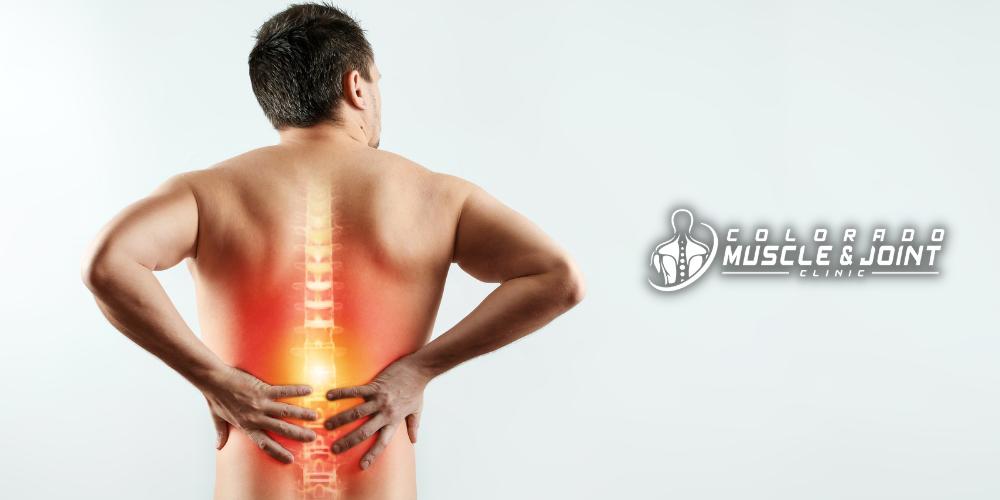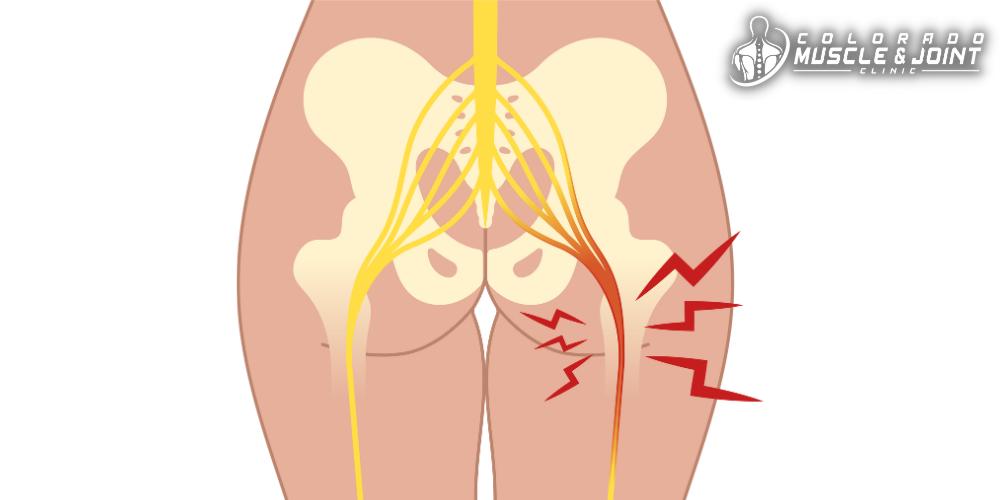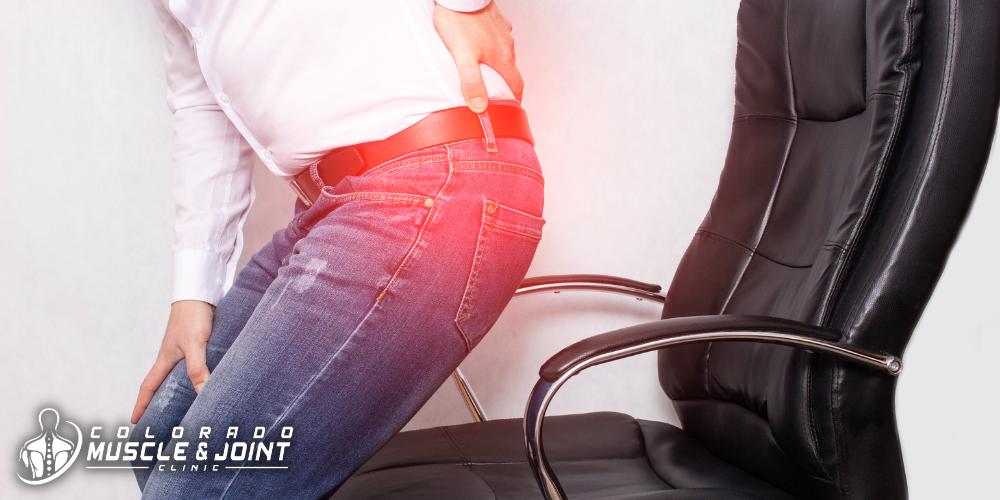Sciatica
Chiropractic Care for Sciatica
Sciatica pain occurs when the sciatic nerve becomes damaged, irritated, or compressed in some way. The symptoms of sciatica can range from mild to debilitating. Many sufferers report tingling, burning, shooting, and stabbing pain down one or both legs. Unless the sciatic pain is caused by an underlying condition – such as spinal stenosis – there is little that the average healthcare provider can do to relieve the patient’s pain. Common treatment options include over-the-counter pain medications, ice packs, hot packs, and maybe even steroid injections.

Many patients are finding relief in other ways, such as through physical therapy and chiropractic care. Dr. Huebner at the Colorado Muscle & Joint Clinic can relieve your sciatica pain through spinal manipulation, myofascial release, and various stretches. Call 970-744-6499 to schedule an appointment at his Loveland, CO clinic today.
What is Sciatica?
Sciatica is a medical condition characterized by nerve pain in the lower back, buttocks, or one or both legs. The pain usually comes from an injury in the musculoskeletal system or pressure on the sciatic nerve.
What is the Sciatic Nerve?
The sciatic nerve is the longest and thickest nerve in the human body. In fact, the width of the nerve is almost the width of a finger. Five nerve roots make up the sciatic nerve: two in the lumbar spine and 3 in the sacrum (the tailbone). The sciatic nerve runs down the butt and both legs and ends right below the knee. As the longest nerve in the body, the sciatic nerve allows you to move your leg muscles and feel sensations such as touch, temperature, and pain.
How Many People Suffer From Sciatica?
Sciatica is a fairly common medical condition in the United States. In fact, approximately 40% of Americans experience sciatica throughout their lifetime according to the Cleveland Clinic.

What Does Sciatica Pain Feel Like?
Sciatic pain feels different for everyone depending on how injured or irritated the nerve is. This type of nerve pain is often described as burning, stabbing, shooting, or tingling in the affected leg. Although the sciatic nerve technically starts in the low back, most people don’t experience low back pain. Instead, they usually feel sciatic pain in their leg(s).
A few things can make the leg pain worse such as sitting or standing for a long time, twisting the body, coughing, or sneezing.
Other sciatica symptoms can include:
- Muscle spasms and/or muscle weakness in the affected leg
- Leg numbness or tingling
- Mild to severe pain in the lower back, butt, or leg(s)
- Bowel or bladder incontinence (due to cauda equina syndrome)
- Lower back or leg pain that gets worse with certain movements
Can Sciatica Happen in Both Legs?
Yes, sciatica pain can happen in both legs, but most of the time it only happens in one leg at a time. The leg that is affected depends on the location of the pinched nerve in the lower spine.

What Causes Sciatica?
Often times, sciatica occurs due to one of the following medical conditions:
- Herniated Disk: This is the most common cause of sciatica pain among Americans. Each spinal bone (vertebra) is separated by a soft disk that allows our spines to bend and move without pain. A slipped disk is a condition in which the soft center of a disk bulges out between the spinal bones. Usually when this happens, the bulge puts pressure on one of the 31 pairs of spinal nerves. This is where nerve pain begins.
- Spinal Stenosis is a condition characterized by the narrowing of the spinal canal. This narrowing can also put pressure on the sciatic nerve.
- Degenerative Disk Disease occurs when the soft disks between the vertebrae get worn down and cause pain throughout the body. Disk degeneration usually occurs due to old age or frequent, strenuous movements.
- Osteoarthritis occurs when the joint tissues get worn down with age. This condition can lead to bone spurs within the joints which can cause pain. If someone has spinal osteoarthritis, these bone spurs can put pressure on the nerve, leading to sciatica pain.
- Spondylolisthesis occurs when one of the vertebrae moves out of place. This condition most commonly occurs in the lower back. A misplaced vertebra can easily put pressure on the spinal nerves.
- Cauda Equina Syndrome occurs when one or more nerves at the bottom of the spinal cord become compressed or damaged. People with this condition experience a wide variety of symptoms. For example, they may lose feeling and movement in the lower half of the body. They may also have bladder or bowel incontinence.
- Piriformis Syndrome is a neuromuscular disorder that occurs when a small muscle in the butt, called the piriformis muscle, spasms or tightens. Spasming or tight muscles in the butt can easily put pressure on the sciatic nerve.
- Traumatic Injuries in the lower back or spine, such as fractured vertebrae.
- Spinal Tumors can also put pressure on the sciatic nerve.
Risk Factors for Sciatica
You may have an increased risk of developing sciatica symptoms if you:
- Are Older Than 50: The spine and the spinal discs naturally degrade as you get older. This may mean you develop a herniated disk, which then leads to sciatica.
- Have a Spinal Injury: Past or current spinal injuries can definitely increase your risks of developing sciatica pain.
- Have Weak Core Muscles: Strong core muscles take pressure off the back and spine, leading to less injury and degradation over time.
- Are Overweight: Carrying excess weight in the abdomen is bad for the back long-term. This puts excess strain on everything: the back muscles, the spine, the spinal discs, and even the spinal nerves.
- Do Physical Labor: If your job is physically demanding, you’re at a greater risk of damaging your back, spine, and spinal nerves.
- Do Heavy Lifting With Poor Posture: Whether you’re lifting heavy weights in the gym or heavy boxes during a move, you need to have good posture while doing so. If not, you’ll throw your back out, and even develop sciatica pain.
- Have Diabetes: Diabetes – especially gone untreated – can lead to extensive nerve damage all over the body. This can lead to sciatica pain for many diabetic patients.
- Have Osteoarthritis: As previously explained, osteoarthritis can lead to bone spurs and other damage within the spine. This can lead to compressed spinal nerves and pain.
- Smoke: Smoking is bad for every single system in the body. Regarding the musculoskeletal system – a lifetime of nicotine and tobacco inhalation can lead to brittle bones in the spine, which can lead to spinal nerve damage.
- Don’t Exercise Regularly: Prolonged sitting at a desk job and at home can lead to all sorts of health issues. Most notably, being inactive leads to weak and inflexible muscles, especially in the back. Weak muscles can raise your risks of musculoskeletal injury and pain.
- Are Pregnant: Pregnancy can lead to all sorts of ailments, aches, and pains due to hormonal fluctuations and weight gain. Excess weight in the abdominal area can lead to herniated discs and compressed nerves. Additionally, abnormal fetal positioning can put pressure on various nerves.

Can a Chiropractor Help With Sciatica?
The treatment plan for someone with sciatica pain will depend on the underlying cause of the condition. Most doctors recommend at-home treatments to ease the pain, like gentle stretching, pain medications, and ice or heat therapy.
But did you know that holistic medicine can also ease or get rid of sciatica pain? It’s true – physical therapy or chiropractic care can often provide more pain relief than the average Ibuprofen.
Chiropractic care is one of many forms of holistic medicine that emphasizes the body’s ability to heal itself from a variety of conditions, including sciatica.
Chiropractic Treatments for Sciatica
There are a few chiropractic treatments that Dr. Huebner offers which may provide sciatica pain relief, including:
- Spinal Manipulation is a type of manual therapy. During this treatment, a chiropractor will use their hands to apply a quick, controlled thrust in order to realign the spinal joints. Chiropractic adjustments may relieve pressure on compressed spinal nerves, therefore reducing pain.
- Myofascial Release – also known as Trigger Point Therapy – is a type of deep tissue massage that’s supposed to relieve muscle tightness and pain. If your lower back or butt muscles are to blame for sciatica pain, this treatment may provide relief.
Other Natural Ways to Relieve Pain From Sciatica
Chiropractors like Dr. Huebner may also recommend lifestyle modifications and other drug-free treatment options where they see fit. As long as the root cause of sciatica pain isn’t a serious medical condition like spinal stenosis or spinal tumors, the pain can usually be managed through regular movement.
Forms of exercise like yoga, dance, and even walking are great ways to stretch and strengthen the body. It’s also important to strengthen your back and core muscles to manage sciatica. The less pressure you put on your back and spine, the better. Dr. Huebner may recommend exercises like planks and crunches to strengthen the core.
Other easy ways to manage sciatica pain include using ice or heat therapy as well as taking frequent breaks from work, especially if you have a desk job.


